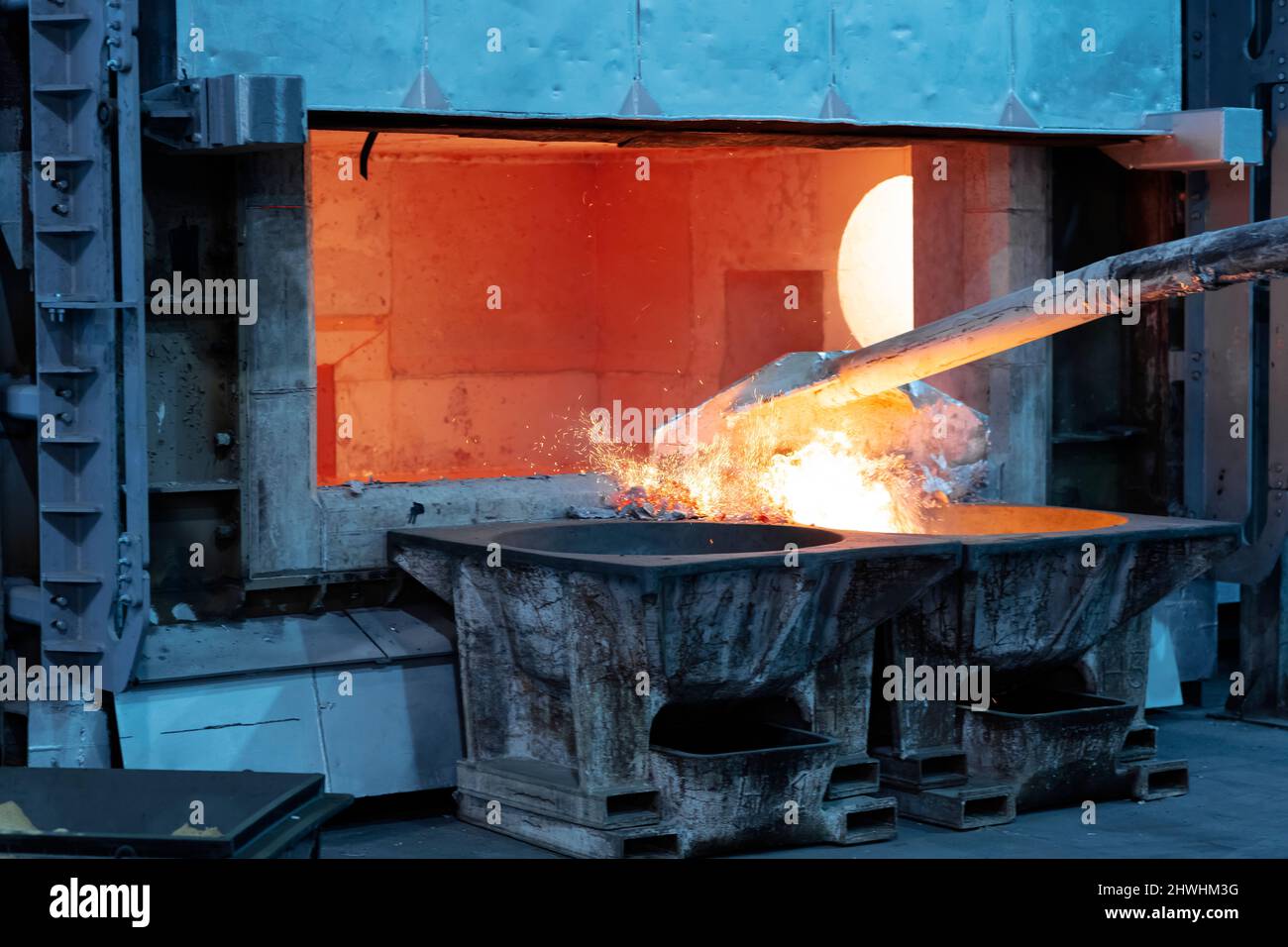Appreciating the role of Aluminum Foundry Wisconsin in casting efficiency
Wiki Article
Just How Aluminum Foundry Adds To Developments in Aerospace Engineering
Aluminum factories are essential to advancements in aerospace design. They create light-weight, high-strength parts that are necessary for contemporary airplane. Via innovative casting techniques, these shops create complicated geometries that improve architectural integrity. Additionally, the growth of superior Aluminum alloys supports the market's concentrate on fuel efficiency and sustainability. Difficulties stay in the manufacturing procedure. Recognizing these factors reveals the profound effect of Aluminum on aeronautics's future.The Importance of Lightweight Materials in Aerospace Layout
As the aerospace market continues to progress, the relevance of lightweight products becomes increasingly evident. The demand for effectiveness and sustainability drives engineers to focus on making use of materials that reduce overall weight without compromising architectural honesty. Lightweight materials, especially Aluminum, play a vital function in improving gas efficiency, boosting payload capacity, and enhancing the general efficiency of airplane.The combination of these products permits for innovative styles, making it possible for manufacturers to create more wind resistant forms that can endure extreme conditions. The decrease in weight not only reduces functional costs yet also adds to a lowered environmental footprint, straightening with international initiatives toward sustainability in aeronautics.
Advanced Spreading Techniques in Aluminum Foundries
Advanced casting techniques in Aluminum shops play a critical duty in aerospace design by making it possible for the manufacturing of lightweight and exact components. Developments in mold style and accuracy spreading processes are important in attaining suitable performance and structural stability. Furthermore, the advancement of lightweight alloys enhances the total efficiency and performance of aerospace applications.Cutting-edge Mold Design
Ingenious mold style plays a necessary function in the efficiency and effectiveness of Aluminum factories, particularly within the aerospace industry. By leveraging advanced materials and techniques, contemporary molds can be engineered to hold up against high temperature levels and pressures, making sure peak performance during the spreading process. These styles usually include intricate geometries that enable the manufacturing of light-weight yet structurally sound components, crucial for aerospace applications. In addition, making use of computer-aided style (CAD) software assists in specific modeling, enabling foundries to imitate and improve mold styles prior to physical manufacturing begins. This not only enhances the high quality of cast components but also reduces waste and lead times, leading to significant price financial savings. On the whole, cutting-edge mold design is a keystone of progression in Aluminum Foundry modern technology for aerospace design.Precision Casting Procedures
The efficiency of cutting-edge mold and mildew designs flawlessly incorporates with precision spreading procedures, which are crucial for producing top notch Aluminum components in aerospace design. These procedures, consisting of sand spreading, die spreading, and investment spreading, assure the production of complicated geometries with tight resistances. Advanced techniques like vacuum cleaner casting and pressure die casting improve the honesty and surface finish of the final items. Accuracy spreading minimizes product waste while making best use of the mechanical buildings of Aluminum, critical for aerospace applications. Furthermore, utilizing real-time surveillance and advanced simulation tools throughout the spreading procedure permits instant changes, bring about enhanced high quality control. Collectively, these accuracy spreading processes position Aluminum shops at the center of aerospace advancement, supporting the industry's need for reliability and performance.Light-weight Alloy Development
As aerospace designers look for to enhance gas performance and efficiency, lightweight alloy development comes to be a necessary focus in Aluminum factories. These foundries employ innovative spreading techniques to develop alloys that provide premium strength-to-weight proportions. Advancements in alloy make-up, including the unification of aspects like lithium and magnesium, enable the manufacturing of products that withstand severe problems while reducing total aircraft weight. Methods such as die spreading and investment casting assist in the precision manufacturing of complex forms, which are essential for aerospace applications. Additionally, recurring study aims to maximize these alloys for improved mechanical buildings and boosted resilience. By focusing on lightweight alloy advancement, Aluminum foundries substantially add to the evolution of aerospace design, leading the method for extra efficient and sustainable aircraft designs.
Enhancing Architectural Honesty Via Aluminum Components
Aluminum parts provide considerable benefits in improving architectural integrity within aerospace design. Their lightweight nature adds to total performance while maintaining toughness, which is important for aircraft efficiency. In addition, the stress and anxiety resistance residential properties of Aluminum aid ensure the durability and integrity of aerospace structures under numerous operational problems.
Lightweight Product Advantages
While traditional products usually jeopardize weight for strength, utilizing Aluminum elements in aerospace design uses substantial advantages in architectural honesty. Aluminum's lightweight nature adds to general style performance, enabling even more streamlined airplane that take in less gas, consequently improving sustainability. The product's superb strength-to-weight ratio guarantees that components maintain sturdiness without including unnecessary mass. This quality cultivates improved performance and agility in trip, along with enhanced haul capabilities. In addition, anonymous Aluminum's resistance to deterioration prolongs the lifespan of aerospace structures, decreasing upkeep expenses and boosting safety and security. As makers progressively adopt Aluminum alloys, the aerospace industry experiences a transformative shift in the direction of more effective and efficient design remedies that prioritize both efficiency and environmental responsibility.Anxiety Resistance Qualities
Numerous products have one-of-a-kind properties, Aluminum's phenomenal stress and anxiety resistance stands out as an important variable in improving the structural honesty of aerospace components. This resistance plays a crucial function in guaranteeing that aircraft can stand up to numerous operational stress and anxieties, including tiredness, influence, and ecological conditions. Aluminum alloys, specifically engineered for aerospace applications, display high tensile strength like this while preserving lightweight characteristics, enabling designers to make more reliable frameworks - Aluminum Foundry. Furthermore, the capacity of Aluminum to endure cyclic loading without substantial deformation adds to the long life and dependability of aerospace parts. As developments proceed in Aluminum Foundry strategies, the development of stress-resistant Aluminum elements assures additional improvements in performance, security, and performance across the aerospace industry, strengthening Aluminum's duty as a recommended material in contemporary designGas Performance Improvements Driven by Aluminum Innovations
As the aerospace sector looks for to boost gas performance, ingenious uses Aluminum have become a necessary remedy. Aluminum's light-weight nature especially reduces airplane weight, enabling lower gas consumption during trip. This reduction in weight is vital, as even little decreases can cause substantial enhancements in total fuel economic climate.Advanced Aluminum alloys, designed for improved stamina and longevity, allow manufacturers to create parts that keep structural integrity while lessening mass - Aluminum Foundry. Additionally, the combination of Aluminum in airframes and engine elements assists in boosted the rules of aerodynamics, adding to minimized drag and raised efficiency
The adoption of Aluminum in aerospace not just meets the demand for fuel-efficient style yet also aligns with regulatory stress for lower exhausts. As these developments continue to advance, they play a substantial duty in setting new benchmarks for gas effectiveness, ensuring that the aerospace field can satisfy expanding ecological and financial difficulties.

The Role of Aluminum in Sustainable Aviation Practices
The raising emphasis on sustainable air travel practices has actually positioned Aluminum as a crucial product in the pursuit for greener airplane style. Known for its lightweight residential or commercial properties, Aluminum substantially decreases aircraft weight, resulting in lower gas consumption and emissions. Its recyclability additionally improves its sustainability account, as Aluminum can be recycled forever useful reference without loss of top quality. This particular supports a circular economic situation within the air travel field, minimizing waste and source depletion.Additionally, advancements in Aluminum alloys have boosted their strength and deterioration resistance, enabling longer solution life and decreased maintenance requirements. These developments help with the growth of a lot more effective aircraft frameworks, adding to overall sustainability efforts. In addition, Aluminum's thermal conductivity plays a vital function in energy-efficient styles, improving systems such as warmth exchangers. Jointly, these attributes emphasize Aluminum's crucial role beforehand sustainable aeronautics, lining up with worldwide initiatives targeted at reducing the environmental impact of air travel.
Challenges Faced by Aluminum Foundries in Aerospace Production
While Aluminum factories play a vital function in aerospace production, they face significant obstacles that can affect manufacturing efficiency and quality. One significant difficulty is the strict quality assurance criteria called for in the aerospace industry. Any kind of issue can jeopardize security and performance, demanding strenuous inspection procedures that prolong manufacturing timelines. Furthermore, factories usually emulate fluctuating basic material prices, which can impact rates and profitability. The complexity of Aluminum alloys utilized in aerospace applications further makes complex the production process, as accurate formulations are vital for attaining preferred mechanical properties. Proficient labor shortages prevent the ability to keep high-grade manufacturing degrees. Lastly, environmental guidelines impose limitations on exhausts and waste monitoring, requiring foundries to purchase sustainable practices, which can be cost-prohibitive. These factors collectively create a landscape where Aluminum factories need to continuously adjust to fulfill the developing needs of aerospace manufacturing while ensuring safety and security and compliance.Future Trends in Aluminum Applications for Aerospace Design
With developments in innovation and raising demands for effectiveness, the future of Aluminum applications in aerospace design is positioned for significant improvement. The integration of innovative Aluminum alloys and composites is anticipated to enhance strength-to-weight proportions, bring about even more fuel-efficient aircraft styles. Furthermore, advancements in additive manufacturing techniques will certainly allow for the production of complex Aluminum frameworks that were formerly difficult, maximizing performance and reducing waste.
Lasting practices will certainly play a vital duty, with an expanding focus on reusing Aluminum to decrease ecological impact. The aerospace field is most likely to accept smarter manufacturing processes, such as automation and expert system, guaranteeing better and accuracy in Aluminum elements. Collaborations between Aluminum foundries and aerospace companies will cultivate research and growth, paving the method for brand-new applications that satisfy the stringent requirements of contemporary aerospace design. In general, the future looks assuring for Aluminum's duty fit the skies
Frequently Asked Inquiries
What Are the Ecological Influences of Aluminum Production in Aerospace?
The ecological impacts of Aluminum production in aerospace consist of significant energy usage, greenhouse gas exhausts, and habitat disruption. Furthermore, mining processes can cause soil degradation and water contamination, raising worries regarding sustainability and ecological balance.Just How Does Aluminum Contrast to Other Products in Aerospace Applications?
Aluminum provides an unique mix of light-weight buildings, deterioration resistance, and cost-effectiveness contrasted to other products. Its high strength-to-weight proportion makes it particularly helpful for aerospace applications, enhancing gas performance and total performance in airplane style.What Qualifications Do Aluminum Foundry Employees Requirement for Aerospace Projects?
Aluminum Foundry workers call for customized training in metallurgy and casting methods, together with knowledge of aerospace sector criteria. Accreditations in high quality control and security protocols are additionally vital to guarantee conformity with rigorous aerospace task requirements.Exist Any Type Of Safety Worries With Making Use Of Aluminum in Aerospace Design?
Safety worries pertaining to Aluminum in aerospace design consist of susceptibility to deterioration, fatigue, and anxiety cracks. Correct therapy and alloy option are necessary to minimize these risks, guaranteeing architectural integrity and overall security in aerospace applications.Exactly How Does Aluminum Recycling Advantage the Aerospace Industry?
Aluminum recycling greatly benefits the aerospace industry by reducing material costs, minimizing ecological influence, and saving energy. This sustainable method improves the market's performance while promoting making use of lightweight, high-performance components in airplane production.Advanced casting strategies in Aluminum shops play a crucial duty in aerospace design by making it possible for the production of light-weight and precise components. Ingenious mold design plays a necessary function in the efficiency and efficiency of Aluminum shops, especially within the aerospace field. As aerospace engineers seek to boost fuel effectiveness and performance, light-weight alloy growth ends up being a necessary focus in Aluminum factories. Aluminum alloys, particularly crafted for aerospace applications, display high tensile toughness while keeping lightweight characteristics, allowing engineers to make a lot more efficient structures. Cooperations between Aluminum foundries and aerospace companies will certainly foster study and advancement, paving the method for brand-new applications that satisfy the stringent demands of contemporary aerospace design.
Report this wiki page